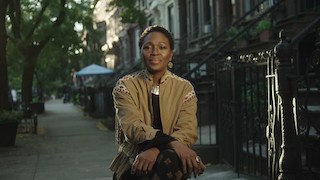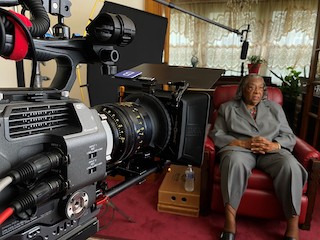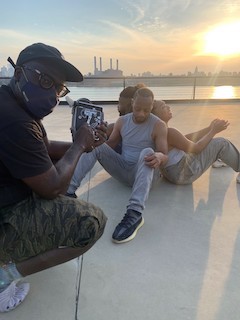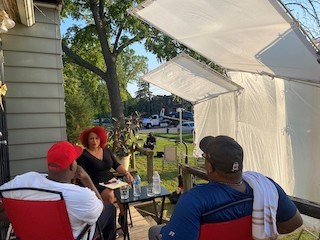 Cinematographer Jerry Henry’s Emmy nomination for the sixth and final episode (Justice) of the Hulu Original TV Mini-docuseries The 1619 Project is just one of three Primetime Creative Arts Emmy nominations – including Outstanding Documentary or Nonfiction Series as well as Outstanding Picture Editing for a Nonfiction Program for the same episode (Adriana Pacheco, Jesse Allain-Marcus and Ephraim Kirkwood) – for the TV adaption of The 1619 Project created by Pulitzer Prize-winning journalist Nikole Hannah-Jones and the New York Times Magazine released by Hulu in January and February of 2023.
Cinematographer Jerry Henry’s Emmy nomination for the sixth and final episode (Justice) of the Hulu Original TV Mini-docuseries The 1619 Project is just one of three Primetime Creative Arts Emmy nominations – including Outstanding Documentary or Nonfiction Series as well as Outstanding Picture Editing for a Nonfiction Program for the same episode (Adriana Pacheco, Jesse Allain-Marcus and Ephraim Kirkwood) – for the TV adaption of The 1619 Project created by Pulitzer Prize-winning journalist Nikole Hannah-Jones and the New York Times Magazine released by Hulu in January and February of 2023.
For those unfamiliar with the importance of the year 1619, the opening of the first episode explains it the best: “In 1619, enslaved Africans were brought across the water. The first to arrive over 400 years ago.” The six-episode series seeks to reframe the United States’ history by placing the consequences of slavery and the contributions of Black Americans at the very center of the country’s national narrative.
To capture the look that he was searching for to tell this story, Henry relied heavily on his personal set of nine Cooke miniS4/i S35 prime lenses because of “the way that it photographs Black people...with a buttery texture to capture the story and make everyone – including people in their 80s – look great. That’s The Cooke Look.” The lenses were mounted on two of Henry’s own Sony PXW-FX9 XDCam 6K Full-Frame Camera Systems for a two-camera 4K shoot, Sony ILME-FX6 Full-Frame Camera System and his Sony Alpha 7S III on a DJI Ronin RS3 gimbal with an E Mount to PL Mount Adapter. Other cameras, including 16mm film and VHS, would also be used.
 Henry had read The 1619 Project a few times. “What stood out to me was capturing the legacy. Stories that aren’t part of history classes – to capture memory and visceral emotions – when to use or not use filtration. I want it to feel intimate.”
Henry had read The 1619 Project a few times. “What stood out to me was capturing the legacy. Stories that aren’t part of history classes – to capture memory and visceral emotions – when to use or not use filtration. I want it to feel intimate.”
Originally slated to have two DPs, conflicts with the co-DP’s schedule eventually lead the project to just have Henry. “Executive producer, director and showrunner Shoshana Guy was the one who asked me to join the project, but COVID pushed production back to August 2021. I started shooting first and then took over the project as Nikole was very happy with my work and decided the project should just stay with one DP so that there would be a consistent look with the visual language throughout the six episodes.”
The 1619 Project was shot over approximately 160 days in New York, Philadelphia, Texas, Georgia, Mississippi, Virginia and almost everywhere in the south. First AC and long-time collaborator Josh Makela would do screen grabs of every interview and color each of them so that Henry could show the producers and directors and to have a frame of reference to what he wanted the scenes to look like, in addition to the LUTs on his monitor. Those colored frames would be sent a year later to the colorist Anthony M. Campagna to provide an initial palette and as a starting place for each episode.
With Hannah-Jones being a fan of older video and archival footage, Henry had to devise a way to integrate some of the material he was shooting with what she would provide for the series. “This is a series about historical info, intimate stories of people,” said Henry. “I need the audience to be engaged but not challenged by the different textures of images they would be seeing. Nikole’s family had been documenting themselves since the 1980s and I was very cognisant of the fact that they went digital in the mid-2000s.”
 To help achieve a consistent look, archived film would be used for some interstitials, mixed with 16mm film shot with Henry’s wind-up Bolex camera using mostly Kodak Vision3 200T with some VIision3 500T added in. One of Henry’s other tricks was with archival video footage such as Hannah-Jones’ high school graduation. He would shoot newly shot VHS-C footage in a contemporary context so it could be used in the edit to provide a seamless viewing experience for the audience.
To help achieve a consistent look, archived film would be used for some interstitials, mixed with 16mm film shot with Henry’s wind-up Bolex camera using mostly Kodak Vision3 200T with some VIision3 500T added in. One of Henry’s other tricks was with archival video footage such as Hannah-Jones’ high school graduation. He would shoot newly shot VHS-C footage in a contemporary context so it could be used in the edit to provide a seamless viewing experience for the audience.
Henry took strong considerations for photographing Black skin in The 1619 Project. “Black people have a wide range of skin tones,” said Henry. “You have to be aware of the way light travels once it reaches the skin. It’s why I have silks on flags on standby, so I can walk in a 4x4. It’s all about the diffused and reflective light for me. In some environments, photographing Nikole was challenging. She has a lighter complexion and vivid red hair that I always wanted to stay true to. When she’s profusely sweating in almost 100 percent humidity, she needs to still photograph attractive. It was a balance between the red of her hair and the lush greens in the environment. For her, I always used reflected light when it was possible.”
For Henry, there was also the need to be protective of what Hannah-Jones was sharing, especially when they shot in her hometown of Waterloo, Iowa with her family.
“Nikole is inviting us into her family, into her world, into a project that was her life’s work,” said Henry. “You’ve got to make sure that everyone feels both protected and comfortable – her mom, uncles, cousins, everyone. I would play back a scene on the monitor, and I would hear ‘It looks really good’ because of the care I took to make them look good. And Nikole understood that when she saw the footage. She knew I was being cognisant with a high level of care, and she had an understanding of what I was doing.”
 Henry has always liked Cooke lenses for the way that “everyone has this warm feeling...it’s subtle, but it’s what made me fall in love with them – with The Cooke Look you don’t get compared to other lenses. Cooke showed me what I saw with my eyes.”
Henry has always liked Cooke lenses for the way that “everyone has this warm feeling...it’s subtle, but it’s what made me fall in love with them – with The Cooke Look you don’t get compared to other lenses. Cooke showed me what I saw with my eyes.”
An opportunity presented itself in 2020 when a rental house in New York was closing shop. They had a set of nine Cooke miniS4/I S35 prime lenses for sale, the full range except for one lens: the 21mm. It was a deal that Henry just couldn’t pass up.
“I had already done my research on Cooke’s, used them on a previous series, and loved that the form factor of the miniS4s allowed them to be used on a gimbal,” said Henry. “So, I bought the nine-lens set.”
That would give Henry the 18mm, 25mm, 32mm, 40mm, 50mm, 65mm, 75mm, 100mm and 135mm. But he doesn’t travel with all nine lenses, just what he knows he needs for each project.
“For The 1619 Project I had the 32mm, 40mm, 65mm, 75mm and the 100mm from the set of nine, the others didn’t travel,” explained Henry. “I like the 40mm the best and used it for every single interview. It gets closer without being intrusive but intimate. I would occasionally go with the 65mm. I like shooting with focal lengths that aren’t traditional, especially on 5K, when the actual focal length of the lens isn’t what you’re actually going to get. I quickly realised that these particular focal lengths on the Super35 lenses covered the 5K sensor mode on the FX9 with little to no vignetting.”
One of the things that Henry noticed is that for a very long time, people would shoot almost wide open to get limited depth of field. “That’s not this story. I want to see the subject in the environment. The miniS4s are a T2.8, but that’s irrelevant for me. I shoot at an aperture that still allows me to separate the foreground from the background, but not remove the background. For me, that’s a T4. It makes for much better storytelling for the person I’m shooting.”
Henry, who also served as one of the camera operators, would use Cooke’s /i Technology lens metadata on set using two 5-inch monitors on stands so that the other camera operator could see what and how he was shooting, and he could see what and how the other camera operator was shooting.
“The S4 is the perfect lens for what I shoot,” said Henry. “Its small form factor lets me use it in cars, gimbals, to follow people around. And I’m truly honored and excited that these S4 lenses helped me get an Emmy nomination.”
